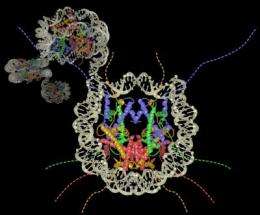Packaging process for genes discovered

Scientists at Penn State University have achieved a major milestone in the attempt to assemble, in a test tube, entire chromosomes from their component parts. The achievement reveals the process a cell uses to package the basic building blocks of an organism's entire genetic code -- its genome. The evidence provided by early research with the new procedure overturns three previous theories of the genome-packaging process and opens the door to a new era of genome-wide biochemistry research. A paper describing the team's achievement will be published in the journal Science on 20 May 2011.
The research was accomplished with the help of a new laboratory procedure developed by the team of scientists led by B. Franklin Pugh, the Willaman Chair in Molecular Biology at Penn State. The procedure allows scientists, for the first time, to do highly controlled biochemical experiments with all the components of an organism's genome.
The team's research is designed to reveal the construction process for the chromosome -- the super-compressed marvel of molecular packaging that contains all an organism's DNA and associated proteins. "Our procedure starts with an entire genome of DNA from yeast cells that we propagate through bacteria, then purify, "Pugh said. "Next, we add equal parts of pure histones, the protein building blocks of chromosomes. Then we allow the assembly process to begin."
The result was that short sections of the lanky string of gene-containing DNA became wound around a series of histone proteins, forming a line of knots called nucleosomes separated by unknotted sections of DNA. Although earlier studies in other labs had shown that histones and DNA alone could construct a series of nucleosome knots along the DNA string, the overall structure of this construction was not nearly as organized as it needed to be in order to look like chromatin inside of a cell -- the material that the cell remodels to form chromosomes. Pugh's team sought out the recipe that would produce the actual, highly organized structure of chromatin.
"Just like baking a mixture of flour and water produces unleavened bread that lacks the texture of leavened bread, so too did the mixture of histones and DNA lack the texture of chromatin," explains Pugh. To provide "texture" to the histone-DNA mix, graduate student Christian Wippo added yeast extract, under the guidance of laboratory head Philipp Korber at the University of Munich, Germany, and co-investigator on the project. "But, like adding yeast to flour and water without the sugar, this was not enough," Pugh said. As Korber recounts, "Once we added ATP, 'the bread began to rise'." In other words, chromatin remodeling enzymes in the extract needed the energy from ATP to reposition the nucleosome knots along the DNA, thereby giving rise to the chromatin the texture that is seen inside of cells. "Chromatin-remodeling enzymes actively pack nucleosomes against barriers that sit at the beginning of every gene, and this process creates uniformly positioned nucleosome arrays," Pugh said.
A critical part of the study that allowed the scientists to "see" the chromatin texture was developed by Graduate Student Zhenhai Zhang, under Pugh's direction. "Because there are more than 60,000 nucleosomes that comprise chromosomes in yeast cells, seeing patterns in this texture would be impossible without the computational pattern-searching algorithms developed by Zhang," Pugh said. Zhang explained, "Remarkably, when all genes were aligned, nucleosomes at the beginning of the genes also aligned, rather being randomly scattered about. Without the yeast extract and ATP, only nucleosome-free zones could be seen at the beginning of genes."
This work is significant because it now allows scientists to experimentally probe the structure and function of chromosomes and their component genes in ways that simply were off limits before. "The cell protects chromosomes from the outside environment, including probing scientists," Pugh said. "We now have a way to study the components of the chromosome outside the protective confines of the cell." Because defects in chromatin organization lead to medical problems -- including certain cancers and developmental disorders -- more direct access to chromatin in its properly organized state is expected to help hasten the search for remedies to many human diseases.
Provided by Pennsylvania State University

















